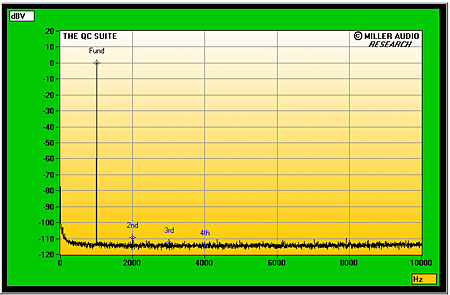| Columns Retired Columns & Blogs |
Simaudio Moon Evolution P-8 preamplifier Measurements
Sidebar 3: Measurements
As set up for Kal's auditioning, the Moon P-8's maximum voltage gain was lower than the specified 9dB, at 5.33dB for both balanced–balanced and unbalanced–unbalanced operation, though this won't be a factor in practical use. The preamplifier preserved absolute polarity—ie, it was noninverting in both conditions—the XLR jacks being wired with pin 2 hot, the AES-recommended practice. The input impedance was to specification at low and midrange frequencies, at 11k ohms single-ended and 22k ohms balanced, though this dropped to a rather low 4.3k and 9.7k ohms, respectively, at 20kHz. The output impedance was also to spec, at a low 50 ohms single-ended and 100 ohms balanced, both figures consistent across the audioband.
The P-8's frequency response was flat within the audioband and 3dB down at a high 200kHz (fig.1). This was the same for all combinations of volume-control setting and load impedance, and for balanced and unbalanced operation. Note also the superb channel matching in this graph. Channel separation was better than 130dB below 2kHz, decreasing to a still superb 115–120dB at 20kHz. As Kal noted, the preamp was also very quiet; its unweighted, wideband signal/noise ratio, measured with the input shorted but the volume control full, was 91dB balanced, 86.3dB unbalanced (both ref. 1V output). A-weighting improved both ratios to 106.7dB!

Fig.1 Simaudio Moon P-8, balanced frequency response at 1V into (from top to bottom at 2kHz): 100k, 600 ohms (0.5dB/vertical div., right channel dashed).
The Moon P-8 could swing high voltages even into low impedances before clipping. Fig.2 plots the THD+noise percentage against single-ended output voltage into loads ranging from 100k ohms down to 600 ohms; the preamp clips (1% THD) at almost 10V into 100k ohms, 8.2V into 600 ohms. The balanced output clipped at 19V into 100k ohms, 15V into 600 ohms. All of these outputs are well above any level the P-8 will be asked to deliver in practical use; more important, the downward slope of the traces in fig.2 indicates that the THD is buried beneath the noise floor at all levels up to actual clipping.

Fig.2 Simaudio Moon P-8, unbalanced distortion (%)vs 1kHz output voltage into (from right to left at 1% THD): 100k, 10k, 1k, 600 ohms.
Fig.3 plots THD+N against frequency at 3V from both the unbalanced and balanced outputs. Under both conditions, the distortion rises out of the noise only above the audioband. Confirming this superb linearity, fig.4 shows a spectral analysis of the Moon P-8's single-ended output while it drove 1kHz at 1V into 8k ohms; other than the second harmonic at –108.5dB (!) all other harmonic components are close to the residual level of my signal generator. The intermodulation distortion (fig.5) was similarly low, with the second-order difference product lying at –96dB (0.0016%).

Fig.3 Simaudio Moon P-8, THD+N (%)vs frequency at 3V into (from bottom to top): 100k, 600 ohms, balanced; 100k, 600 ohms, unbalanced (right channel dashed).

Fig.4 Simaudio Moon P-8, unbalanced spectrum of 1kHz sinewave, DC–10kHz, at 1V into 8k ohms (linear frequency scale).

Fig.5 Simaudio Moon P-8, unbalanced HF intermodulation spectrum, DC–24kHz, 19+20kHz at 1V into 8k ohms (linear frequency scale).
Its superb measured performance reveals Simaudio's Moon P-8 to be a superbly engineered component.—John Atkinson
- Log in or register to post comments




































